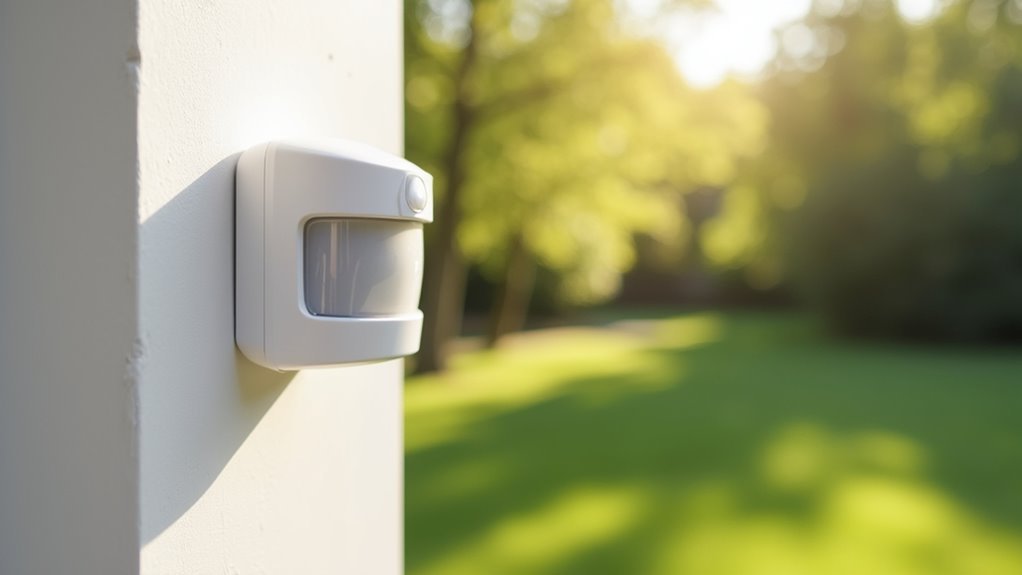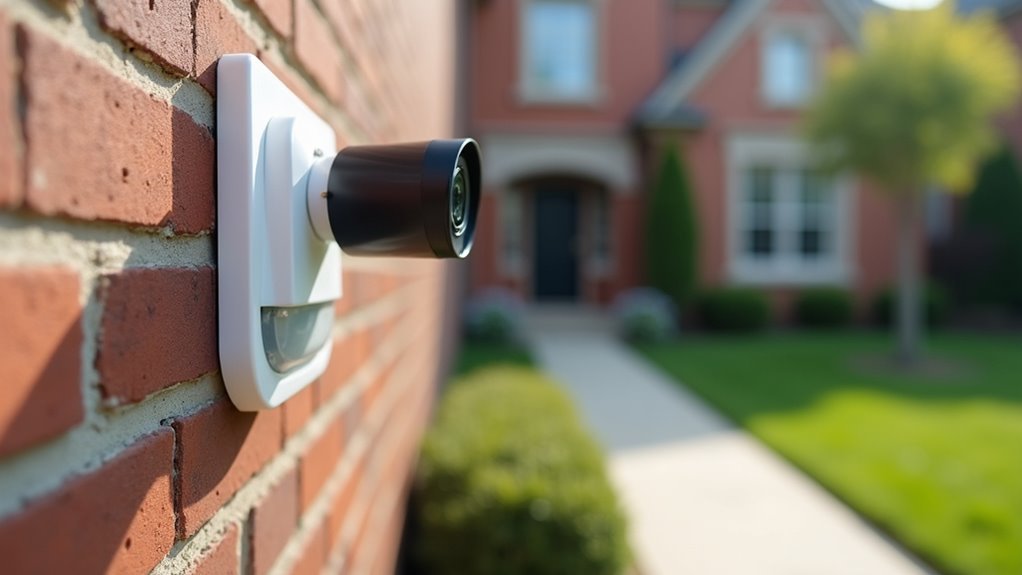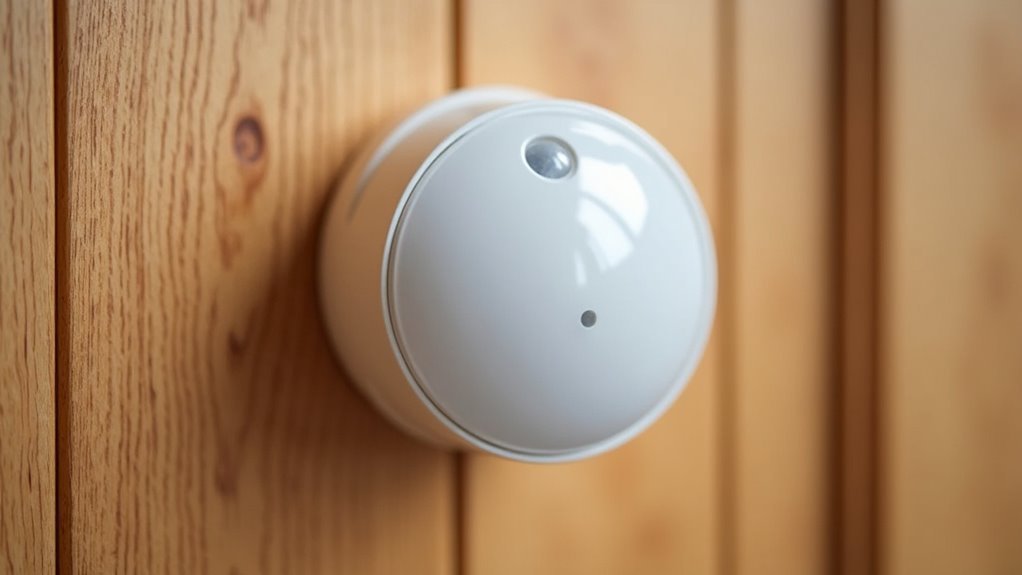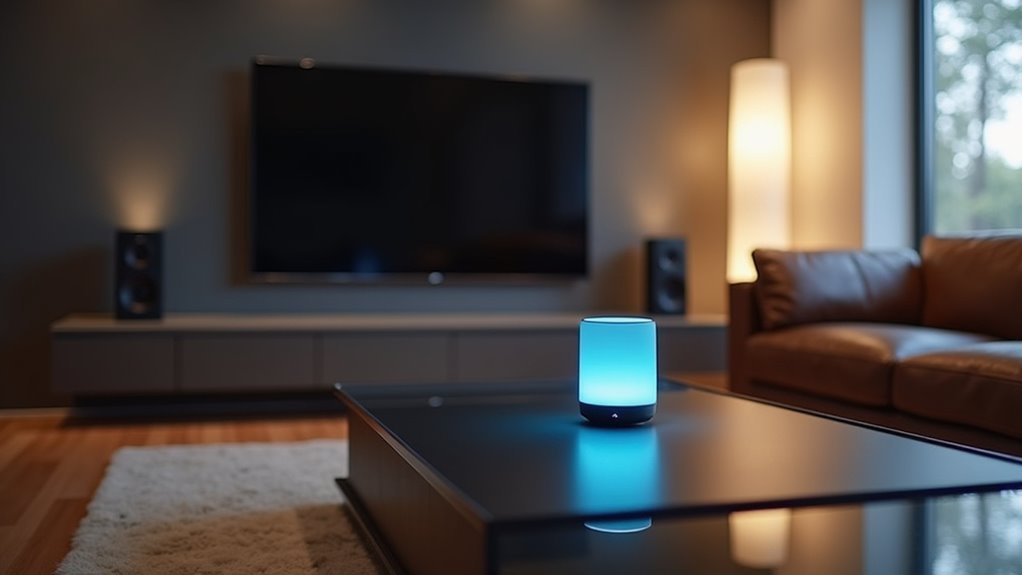You’ll discover that creating the perfect motion sensor setup isn’t just about buying the most expensive device and mounting it on your wall. The difference between a system that constantly triggers false alarms and one that reliably protects your home lies in understanding the intricate balance between sensor technology, strategic placement, and environmental factors. Most homeowners make critical mistakes that compromise their entire security system without even realizing it.
Understanding Motion Sensor Technology and Types

Motion sensors form the backbone of modern security and automation systems, but choosing the right type depends entirely on your specific needs and environment.
You’ll encounter two main categories: passive infrared sensors that detect body heat and active sensors like microwave or ultrasonic units that emit signals to identify movement.
Passive infrared sensors excel in residential settings due to their energy efficiency and cost-effectiveness. They’re perfect for indoor applications where you need reliable detection without high power consumption.
PIR sensors deliver energy-efficient, cost-effective motion detection that’s ideal for residential indoor use with minimal power demands.
Active sensors work better outdoors since they can penetrate walls and cover larger areas, though they’re prone to more false alarms.
For ideal performance, consider dual-technology motion sensors that combine both PIR and microwave technologies, considerably reducing false triggers while maintaining excellent detection capabilities.
Key Components of an Effective Motion Detection System
You’ll need to assess three critical elements when building your motion detection system: choosing the right sensor technology, positioning sensors strategically throughout your space, and connecting them to your existing security or smart home infrastructure.
Each component directly impacts your system’s effectiveness and reliability in detecting unwanted movement.
Let’s examine how these elements work together to create extensive motion coverage for your property.
Sensor Technology Types
When selecting the right motion sensor for your home security system, understanding the different technology types available will help you make an informed decision that matches your specific needs.
The Passive Infrared (PIR) sensor remains the most popular choice due to its reliability and cost-effectiveness in detecting body heat.
Microwave sensors offer broader coverage by emitting pulses to detect movement but can experience interference issues.
Dual-technology motion sensors combine PIR and microwave technologies, requiring both heat and motion detection to trigger alerts, which dramatically reduces false alarms.
Ultrasonic sensors use wave frequency changes to detect movement through obstacles.
Pet-immune sensors provide specialized functionality by ignoring animals below certain weights, making them perfect for households with pets.
Strategic Placement Guidelines
After choosing the right sensor technology for your needs, proper placement becomes the determining factor in your system’s effectiveness.
Position your motion sensors 6 to 8 feet high to maximize detection range and reduce blind spots throughout your coverage areas. Corner installations offer the best vantage points, allowing sensors to detect movement across entire rooms efficiently.
Focus your motion sensor placement on high-traffic areas like doorways, hallways, and main entry points where intruders are most likely to pass.
Avoid installing sensors near heat sources, windows, or large furniture that could obstruct detection or trigger false alarms.
Strategic placement in these key locations guarantees thorough monitoring while maintaining system reliability.
Consider adding visible deterrent signs to enhance your security system’s psychological impact on potential intruders.
Integration With Systems
Modern motion sensors deliver their greatest value when seamlessly integrated with extensive security and smart home systems.
You’ll maximize effectiveness by connecting sensors to your existing smart home security infrastructure, enabling automatic lighting, door locks, and HVAC responses. Choose dual-technology sensors combining passive infrared and microwave detection for superior reliability and fewer false alarms.
Link your motion detection technology directly to security cameras for instant video capture and real-time evidence collection.
Integration with thorough alarm systems guarantees immediate notifications reach both you and monitoring services during potential intrusions. Connect everything to mobile devices through dedicated apps, giving you remote property monitoring and instant alerts regardless of location.
This interconnected approach transforms individual sensors into a cohesive, intelligent security network that responds instantly to threats.
Strategic Placement for Maximum Coverage
You’ll maximize your motion sensor system’s effectiveness by positioning sensors at the right height and angles throughout your space.
Focus on covering key entry points like doorways and staircases where intruders must pass through.
Smart placement also means avoiding common false alarm triggers that can compromise your system’s reliability.
Optimal Height and Angles
Two vital factors determine whether your motion sensor will provide extensive coverage or leave dangerous blind spots: installation height and angle positioning.
You’ll achieve ideal height by mounting sensors between 6 to 8 feet, which maximizes your field of vision while preventing obstructions from furniture or foot traffic. This elevation guarantees your coverage area extends throughout the room effectively.
Proper angles are equally important for thorough detection. Tilt your sensor 20-30 degrees downward to capture movement within your designated zone accurately.
Corner placement enhances these angles by providing diagonal sight lines across entire spaces, eliminating blind spots that straight-wall installations create.
Regular testing of range and sensitivity settings confirms your height and angle choices deliver the precise detection coverage you need for ideal security performance.
Entry Point Coverage
Strategic placement at entry points forms the foundation of effective motion detection throughout your home.
You’ll want to install motion sensors near front and back doors to monitor potential intruders effectively, ensuring thorough doorway coverage. Position sensors to capture the full width of each entry point, eliminating gaps where someone might slip through undetected.
Focus on high-traffic areas like hallways connecting to entry points, creating extensive security solutions that track movement patterns.
Mount sensors in corners near doorways to maximize detection range while avoiding blind spots. You’ll achieve ideal entry point coverage by positioning multiple sensors at critical access points, creating overlapping fields that catch any unauthorized movement before intruders penetrate deeper into your home’s interior spaces.
Avoiding False Alarm Triggers
While thorough entry point coverage establishes your foundational security layer, improper sensor placement can undermine your entire system through frequent false alarms that desensitize you to real threats. Avoiding false alarms requires strategic positioning away from heat sources like radiators and heating vents, maintaining 10-15 feet distance minimum.
| Avoid These Locations | Recommended Alternative |
|---|---|
| Near radiators/heating vents | 10-15 feet away from heat sources |
| Sunny windows | Interior walls or shaded areas |
| Low-traffic corners | High-traffic choke points |
| Pet pathway zones | Elevated mounting positions |
Install pet-immune sensors or adjust sensitivity settings to accommodate household animals. Position sensors in room corners for maximum coverage while avoiding sunny windows and heating elements that interfere with accurate motion detection.
Optimal Mounting Height and Angles
Three key factors determine your motion sensor’s effectiveness: mounting height, angle, and positioning. The ideal mounting height ranges between 6 to 8 feet, maximizing detection range while guaranteeing furniture and objects don’t create blind spots. This elevation helps minimize obstructions that could interfere with proper sensor function.
Angle your sensors slightly downward to enhance their field of view across the monitored area. This positioning allows better movement detection while reducing coverage gaps. Corner placement provides the broadest field of view, enabling extensive room monitoring with fewer sensors.
Maintain proper clearance from heat sources and windows to prevent environmental false alarms. Keep sensors at least 2 inches away from light bulbs to avoid interference.
These strategic placement decisions guarantee reliable detection while minimizing unwanted activations.
Avoiding Common Environmental Interference

Although proper mounting establishes your sensor’s foundation, environmental factors can sabotage even the best-positioned devices.
You’ll want to avoid placing motion sensors near heat sources like radiators or heating vents, which cause false alarms through temperature fluctuations. Direct sunlight streaming through windows interferes with passive infrared sensors, disrupting their detection capabilities.
Don’t install sensors in high-traffic areas where constant movement triggers nuisance alerts, reducing reliability for actual intrusions.
Avoid high-traffic zones to prevent constant false alarms that undermine your security system’s ability to detect genuine threats.
Verify your sensor’s field of view isn’t obstructed by furniture, decorations, or other objects that limit detection range.
Regular maintenance prevents performance degradation.
Clean the sensor surface frequently to remove dust and debris that accumulate over time, blocking movement detection accuracy and compromising your security system’s effectiveness.
Pet-Friendly Motion Sensor Solutions
You’ll need pet-immune sensor technology that distinguishes between your furry friends and potential intruders.
Most systems offer weight-based detection settings that ignore animals under 40 pounds while still capturing human movement.
You can fine-tune sensitivity adjustment options to create the perfect balance between security coverage and eliminating false alarms from pet activity.
Pet-Immune Sensor Technology
How can you enjoy peace of mind with your security system without constantly worrying about false alarms from your furry friends?
Pet-immune sensors use advanced technology to intelligently differentiate between human intruders and your beloved pets. These sophisticated devices can detect movement while filtering out animals weighing up to 40 pounds.
Here’s what makes pet-immune sensors effective:
- Dual-technology systems combine multiple detection methods with adjustable sensitivity settings.
- Strategic placement at 5-7 feet heights keeps sensors above pet reach zones.
- Wide coverage range of 30-50 feet protects larger spaces efficiently.
To reduce false alarms, you’ll need regular maintenance and sensitivity adjustments.
Environmental changes or new pets may affect performance, so periodic recalibration guarantees your system continues protecting your home while accommodating your four-legged family members.
Weight-Based Detection Settings
When configuring your pet-friendly motion sensors, the weight-based detection setting becomes your most essential adjustment for attaining reliable home security. These adjustable sensitivity settings let you customize detection thresholds based on your pet’s size, typically accommodating animals up to 40-80 pounds while maintaining intruder detection capabilities.
| Pet Weight Range | Recommended Setting | Sensor Type |
|---|---|---|
| Under 25 lbs | High sensitivity | Standard PIR |
| 25-50 lbs | Medium sensitivity | Dual-technology sensors |
| 50-80 lbs | Low sensitivity | Advanced PIR |
| Multiple pets | Custom calibration | Dual-technology sensors |
You’ll find that dual-technology sensors offer superior accuracy by combining PIR and microwave detection. This combination guarantees larger movements trigger alerts while filtering out smaller pet movements, giving you peace of mind without constant false alarms disrupting your security system.
Sensitivity Adjustment Options
Most pet-friendly motion sensors offer multiple sensitivity adjustment options that allow you to fine-tune detection capabilities beyond basic weight thresholds.
You’ll find that customizable detection range features let you tailor sensor performance to your specific pet’s size and behavior patterns.
Modern dual-technology sensors provide three key adjustment levels:
- Low sensitivity – Ideal for multiple pets or larger animals up to 40 pounds
- Medium sensitivity – Perfect for single small-to-medium pets with predictable movement patterns
- High sensitivity – Best for homes without pets or areas where maximum detection is required
Many models include dedicated pet modes that automatically calibrate sensitivity settings for peak performance.
You can adjust detection angles and range zones to ignore low-level movement while maintaining security coverage.
Regular testing guarantees your adjustments work effectively with your pets present.
Integration With Smart Home Automation
While standalone motion sensors provide basic detection capabilities, integrating them with your smart home automation system transforms them into powerful components of an all-encompassing security and convenience network.
You’ll receive real-time notifications on your mobile device whenever motion’s detected, allowing immediate control over connected devices. Your smart lighting automatically illuminates areas when movement triggers the sensors, saving energy while improving safety.
Link motion sensors to smart cameras for instant alerts and recorded footage access. You can establish automated routines where detected movement adjusts thermostats or locks doors, streamlining home management.
Modern motion sensors support compatibility with popular smart home platforms, enabling seamless integration and customization of security settings based on your preferences and lifestyle.
Connecting Motion Sensors to Security Cameras

Beyond basic automation features, motion sensors become even more powerful when paired with security cameras to create a robust surveillance system.
When you connect motion sensors to security cameras, you’ll transform your home security systems into an intelligent network that responds instantly to threats.
Here’s how this integration enhances your security:
- Real-time alerts – You’ll receive instant notifications on your mobile device when sensors detect motion and trigger recording.
- Storage optimization – Cameras only record when movement occurs, reducing cloud and local storage costs considerably.
- Comprehensive coverage – Multiple sensors work together to create overlapping detection zones that eliminate blind spots.
This setup doesn’t just deter intruders—it provides vital evidence while maximizing your system’s efficiency and effectiveness.
Professional Vs DIY Installation Considerations
Once you’ve determined the scope of your motion sensor security system, you’ll face an essential decision: whether to install it yourself or hire professionals.
Professional installation guarantees ideal sensor placement through expert knowledge, minimizing blind spots while maximizing coverage effectiveness. You’ll also receive ongoing support and monitoring services for immediate troubleshooting assistance.
DIY installation offers flexibility and cost savings, but demands solid understanding of sensor functionalities and placement strategies. You’ll need to research system integration thoroughly to avoid common pitfalls and ascertain seamless component operation.
Consider your home’s complexity when deciding. Larger or multi-level properties often benefit from professional installation’s efficiency, while simpler layouts may suit DIY approaches.
Professional installers excel at thorough system integration, whereas DIY setups require additional adjustments for ideal motion sensors performance.
Calibrating Sensitivity Settings and Range
After completing your motion sensor installation, proper calibration of sensitivity settings and range becomes essential for ideal system performance.
You’ll need to adjust these settings based on your specific environment to prevent false alarms while maintaining adequate coverage.
Start calibrating the range by following these steps:
Begin range calibration with a systematic approach to ensure your motion sensor delivers optimal detection performance for your specific installation environment.
- Set your sensor to maximum sensitivity (75-100 feet coverage) and walk in progressively wider circles beneath it.
- Watch for the red activation light to confirm proper triggering at desired distances.
- Adjust sensitivity downward if you experience interference from pets, heat sources, or environmental factors.
Configure your “On-Time” setting to determine illumination duration—typically 1, 5, or 10 minutes.
Regular testing guarantees your motion sensor maintains effectiveness while minimizing nuisance triggers from unwanted sources.
Testing and Maintenance Best Practices
Proper calibration sets the foundation, but consistent testing and maintenance keep your motion sensors operating at peak performance.
You’ll want to test your motion sensors every few months to verify they’re functioning correctly and adjust sensitivity settings when needed. Regular maintenance includes cleaning sensor lenses with a microfiber cloth, preventing dust and debris from causing false alarms or detection failures.
Don’t forget to check and replace batteries in battery-operated units according to manufacturer guidelines. This prevents unexpected malfunctions during critical moments.
Ascertain furniture or environmental changes haven’t obstructed sensor views of monitored areas. Document all testing and maintenance activities to track your home security system’s effectiveness.
This systematic approach maintains reliability and guarantees your sensors consistently protect your property when you need them most.
Troubleshooting False Alarms and Missed Detections
When your motion sensors trigger false alarms or miss actual movement, you’re likely dealing with environmental interference, improper calibration, or common placement issues.
You’ll need to identify whether pets, moving objects, heat sources, or direct sunlight are causing unwanted activations, then adjust your sensor’s sensitivity settings accordingly.
Check if dust buildup on the lens or poor positioning near heating vents is affecting detection accuracy, as these factors can greatly impact your system’s reliability.
Common False Alarm Causes
Even the most carefully installed motion sensors can trigger false alarms that’ll frustrate you and potentially compromise your security system’s effectiveness.
Understanding these common causes helps you identify and resolve issues quickly.
The primary culprits behind unwanted alerts include:
- Pet interference – Even pet-immune sensors can trigger from larger animals or unexpected movements from smaller pets climbing furniture or jumping.
- Environmental factors – Direct sunlight, heating vents, and drafts interfere with sensor functionality, causing incorrect detections or missed genuine threats.
- Poor sensor placement and sensitivity settings – Mounting sensors too low, placing them in high-traffic areas, or setting sensitivity levels too high causes reactions to minor movements like blowing leaves or passing vehicles, generating unnecessary alerts that undermine system reliability.
Environmental Detection Interference
Environmental interference creates some of the trickiest motion sensor problems you’ll encounter because these factors constantly change throughout the day.
Direct sunlight streaming through windows, heating vents cycling on and off, and large furniture blocking detection zones all contribute to unreliable performance. These environmental factors can trigger false alarms or cause missed detections when you need them most.
Temperature changes pose particular challenges since sensors rely on heat signatures to detect movement.
Keep your sensors at least 10-15 feet from heat sources like radiators, vents, or appliances. You’ll also need to adjust sensitivity settings based on your specific environment – lower settings reduce false triggers while higher settings catch subtle movements.
Regular lens cleaning prevents dust accumulation that degrades detection accuracy.
Sensor Calibration Adjustments
After identifying environmental interference issues, you’ll need to fine-tune your sensor’s calibration settings to eliminate false alarms and prevent missed detections.
Proper sensor calibration adjustments guarantee your motion detector operates at peak performance in any environment. Here’s how to calibrate effectively:
- Adjust the sensitivity settings through your sensor’s control panel or app interface to minimize false alarms from small pets or environmental factors while maintaining detection accuracy.
- Clean the sensor lens periodically to remove dust and debris that can obstruct motion detection capabilities and cause missed activations.
- Re-calibrate the sensor after any significant environmental changes, such as new furniture placement or landscaping modifications, to maintain consistent performance.
Regular testing by walking beneath the sensor helps verify these calibration adjustments are working correctly.
Enhancing Security With Multi-Sensor Setups
When you’re serious about home security, relying on a single motion sensor leaves dangerous gaps in your coverage. A multi-sensor setup dramatically improves your enhanced security by eliminating blind spots and monitoring multiple entry points simultaneously.
You’ll want to combine different sensor types—passive infrared sensors that detect the infrared radiation from body heat work perfectly alongside microwave sensors for superior accuracy and fewer false alarms.
Strategic placement in corners and choke points maximizes your detection range, creating overlapping coverage zones that catch intruders before they reach vulnerable areas.
Integration with smart home systems provides instant alerts and automated responses like activating cameras or lights.
Remember to test your motion sensors regularly and adjust sensitivity settings based on seasonal changes to maintain peak performance throughout the year.
Advanced Features and Smart Technology Options
Beyond basic multi-sensor configurations, today’s motion detectors pack sophisticated features that transform them from simple alarm triggers into intelligent security components.
These advanced features include dual-technology sensors that combine PIR and microwave detection, dramatically reducing false alarms while maintaining sensitivity.
Smart technology options enable seamless integration with home automation systems, allowing you to program custom responses like automated lighting, door access, or instant mobile alerts.
Consider these key capabilities:
- Pet-immune technology – Ignore smaller animals while detecting human movement
- Time-based programming – Adjust sensitivity and responses based on schedules
- Cloud connectivity – Access remote monitoring, real-time notifications, and video recordings
Modern motion sensors adapt to environmental conditions and connect to cloud services, providing thorough security awareness that goes far beyond traditional detection methods.
Frequently Asked Questions
How to Setup a Motion Sensor?
Mount your motion sensor 6-8 feet high in room corners, away from windows and heat sources. Secure it with proper angling, test detection range by walking underneath, and regularly clean to maintain peak performance.
What Is the Best Sensor Positioning?
You’ll get ideal sensor positioning by mounting them 6-8 feet high in room corners, away from heat sources and high-traffic areas, while strategically placing them near doors and windows for thorough coverage.
What Sets off a Motion Sensor?
You’ll trigger motion sensors through body heat changes, but pets, moving trees, passing cars, and heat sources can also set them off. Microwave sensors detect broader movements while PIR sensors focus on infrared energy shifts.
How High up Should You Put a Motion Sensor?
You should mount your motion sensor 6 to 8 feet above ground level. This height provides ideal detection coverage while preventing false alarms from pets and small objects moving below the sensor’s range.





Leave a Reply